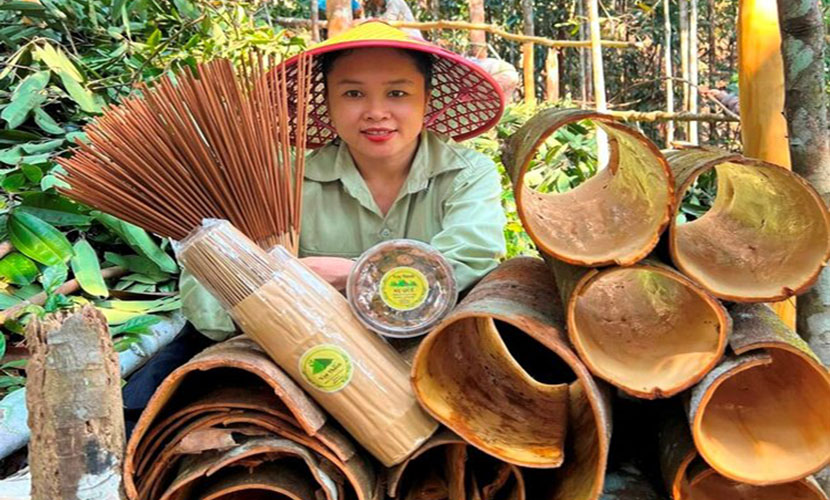
Tra Bong cinnamon is considered one of Vietnam’s most famous natural specialties. Currently, local farmers are busy with the cinnamon harvest season.
Quang Ngai province has the second-largest cinnamon-growing area in Vietnam, with the majority in Tra Bong district. The entire district currently has about 5,500 hectares of cinnamon plantations. Alongside maintaining the current area, the district is implementing a plan to expand its cinnamon plantations. It has aimed to increase the total area to 6,000 hectares by 2030.

Tra Bong cinnamon
As the cinnamon harvest season is underway, local farmers are bustling with activity. Some head to the hills to strip the cinnamon bark, while others dry the bark and sell it to traders. Currently, selling price of fresh cinnamon is between 15,000 to 16,000 VND per kilogram. In the meanwhile, dried bark sells for 40,000 to 45,000 VND per kilogram.
According to Mr. Sang, a local farmer, his family owns more than 5,000 cinnamon trees. In which, there are 600 mature trees that are able to harvest. With the current selling price, his family can earn a few dozen million Vietnamese dongs.
As the current price of cinnamon is still relatively low, so profits are not as high as his expectation. “In previous years, the price of fresh cinnamon bark sometimes reached 25,000 VND per kilogram, and everyone was very happy,” he said.

Cinnamon harvesting season in Tra Bong
Although this year’s prices are below expectations, local farmers are still happy with the stable income from Tra Bong cinnamon. “Since the beginning of the season, I’ve earned nearly 10 million VND selling cinnamon barks to traders. This income helps cover my living expenses. My family still has over 600 mature cinnamon trees left to harvest. Hopefully, prices will rise in the near future so we can earn more profit,” said Ms. Truc from Tra Hiep commune.
In the “cinnamon capital” of Tra Bong, there are two cinnamon harvest seasons each year. The first season lasts from late February to the end of April. It is the “fairy season” by the Cor ethnic people. Iin addition, the second takes place from July to August.
“During these periods, the bark peels off easily and contains high levels of essential oil. That’s why the harvest must be done quickly, because off-season, the bark sticks tightly to the trunk and is difficult to peel,” Ms. Truc explained.
Alongside other crops, cinnamon is one of the key plants in Tra Bong district. Almost every household of the Cor ethnic group grows cinnamon. Even smaller households grow over 1,000 trees, while larger ones manage several hectares. From a traditional crop, cinnamon has become an important driver of sustainable economic development and poverty alleviation. Thanks to cinnamon farming, many households have escaped poverty and built better lives.

Tra Bong cinnamon incense
Mr. Suong, Vice Chairman of the district, stated that cinnamon is a traditional crop of the Cor people. Moreover, it has also been recognized as a national specialty and honored by the Asia Book of Records as a specialty gift of Asia. As one of the four key cassia-producing regions in Vietnam, with an annual harvest of 1,800 to 2,000 tons, Tra Bong cinnamon not only meets domestic demand but also reaches international markets.
Tra Bong cinnamon products are highly valuable for their distinctive aroma and high essential oil content. As a result, they are popular both domestically and in many countries such as China, France, India, and South Korea. Today, cinnamon essential oil and handicraft items made from cinnamon bark—such as jars, cups, tea boxes, toothpicks, and incense sticks—are in strong demand.
Vietnamese source: https://laodong.vn/kinh-doanh/quang-ngai-vao-mua-thu-hoach-que-tra-bong-1484602.ldo
